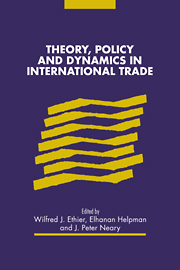Book contents
- Frontmatter
- Contents
- List of conference participants
- I Introduction
- II History, geography and the theory of trade
- III The structure of simple trade models
- IV Policy towards international trade
- V Trade, growth and dynamics
- 11 Prices of goods and factors in a dynamic stochastic economy
- 12 Capital market imperfections and the infant industry argument for protection
- 13 Endogenous real business cycles and international Specialization
- 14 Impact of government on growth and trade
- 15 Long-run production frontiers for the Jones specific-factors model with optimal capital accumulation
- 16 Hysteresis in the trade pattern
- Index
12 - Capital market imperfections and the infant industry argument for protection
Published online by Cambridge University Press: 16 March 2010
- Frontmatter
- Contents
- List of conference participants
- I Introduction
- II History, geography and the theory of trade
- III The structure of simple trade models
- IV Policy towards international trade
- V Trade, growth and dynamics
- 11 Prices of goods and factors in a dynamic stochastic economy
- 12 Capital market imperfections and the infant industry argument for protection
- 13 Endogenous real business cycles and international Specialization
- 14 Impact of government on growth and trade
- 15 Long-run production frontiers for the Jones specific-factors model with optimal capital accumulation
- 16 Hysteresis in the trade pattern
- Index
Summary
This chapter analyzes the role for infant industry protection in the presence of capital market imperfections. A two good, two period model of a small open economy will be presented in which one of the sectors has the characteristics of an “infant” industry. Firms in the infant industry are unprofitable at world prices in the first period. During the first period when losses are being incurred, entrepreneurs learn about the production process. In the second period, firms become profitable (on average) at world prices. The approach to capital market imperfections in this paper is to treat them as resulting from the agency costs associated with external finance when there is private information on the part of entrepreneurs. This model will then be used to examine whether government intervention in support of the infant industry can yield Pareto-improvements.
The traditional treatment of capital market imperfections (Baldwin [1969], Corden [1974]) is to model the capital market imperfection as an exogenously given wedge between the social cost of capital and the rate at which firms can borrow from the private sector. Since the future profits are being discounted at too high a rate by private sector lenders, there will be too little entry into the infant industry. Two main policy conclusions emerge from this literature. The first is that subsidies to the infant sector are desirable, because they make the amount of entry closer to the socially optimal level. The second is that direct intervention in the capital market, such as through subsidized loans, is preferable to indirect intervention in the form of production subsidies or tariffs.
- Type
- Chapter
- Information
- Theory, Policy and Dynamics in International Trade , pp. 191 - 212Publisher: Cambridge University PressPrint publication year: 1993
- 1
- Cited by

